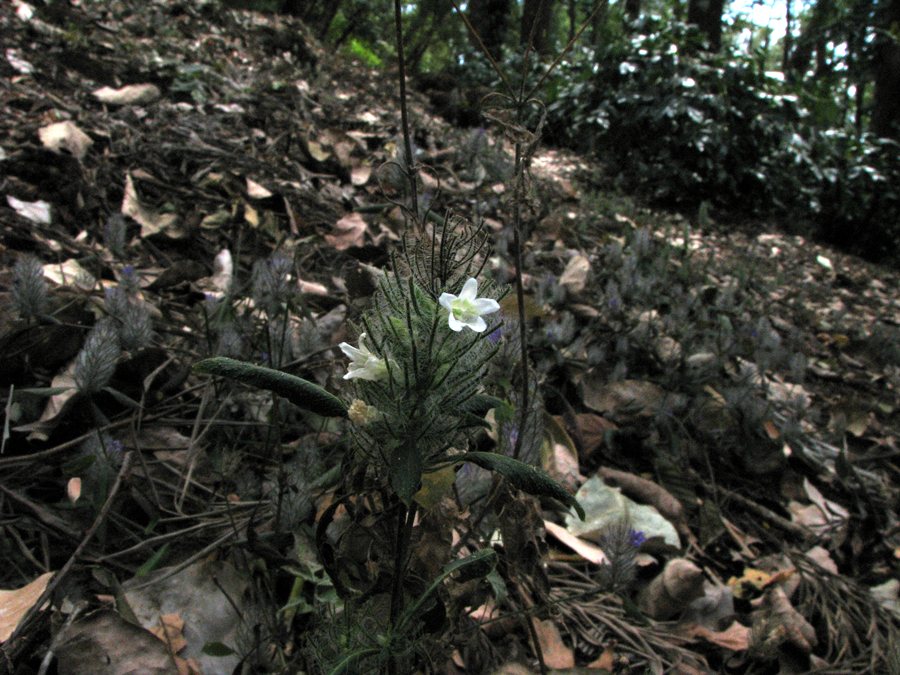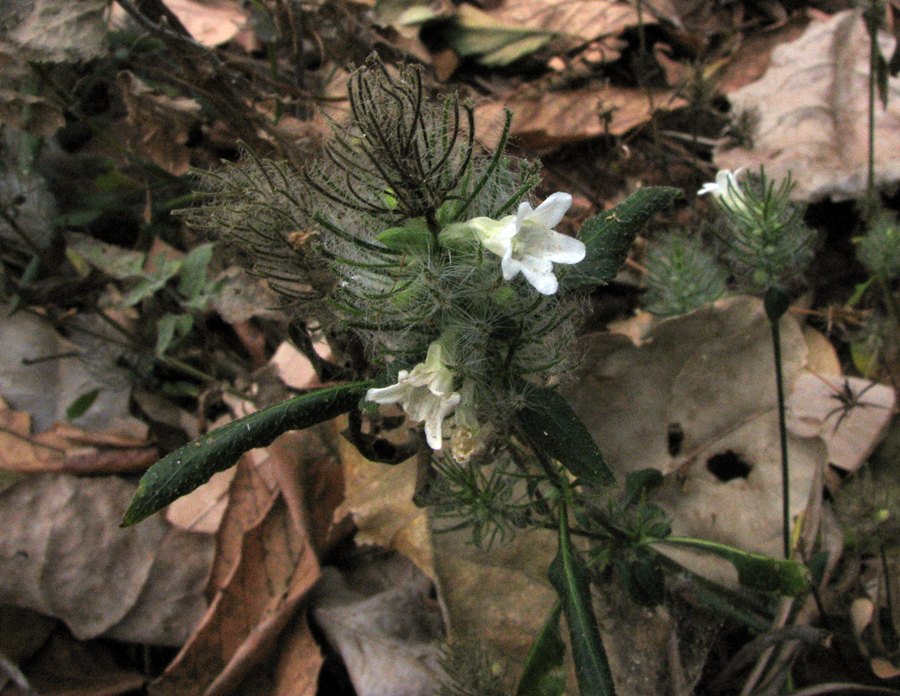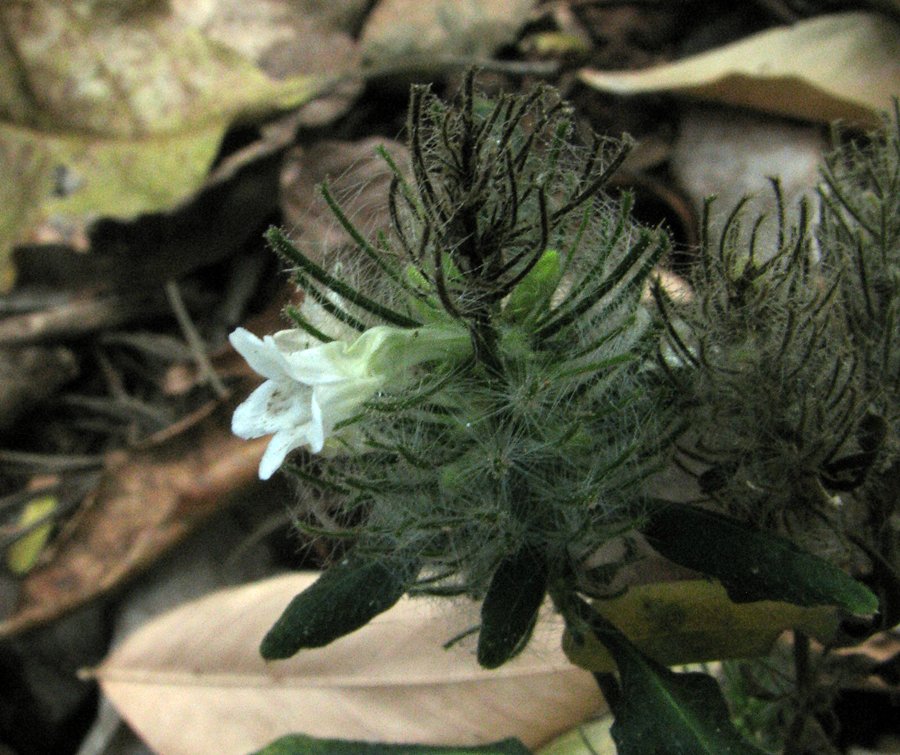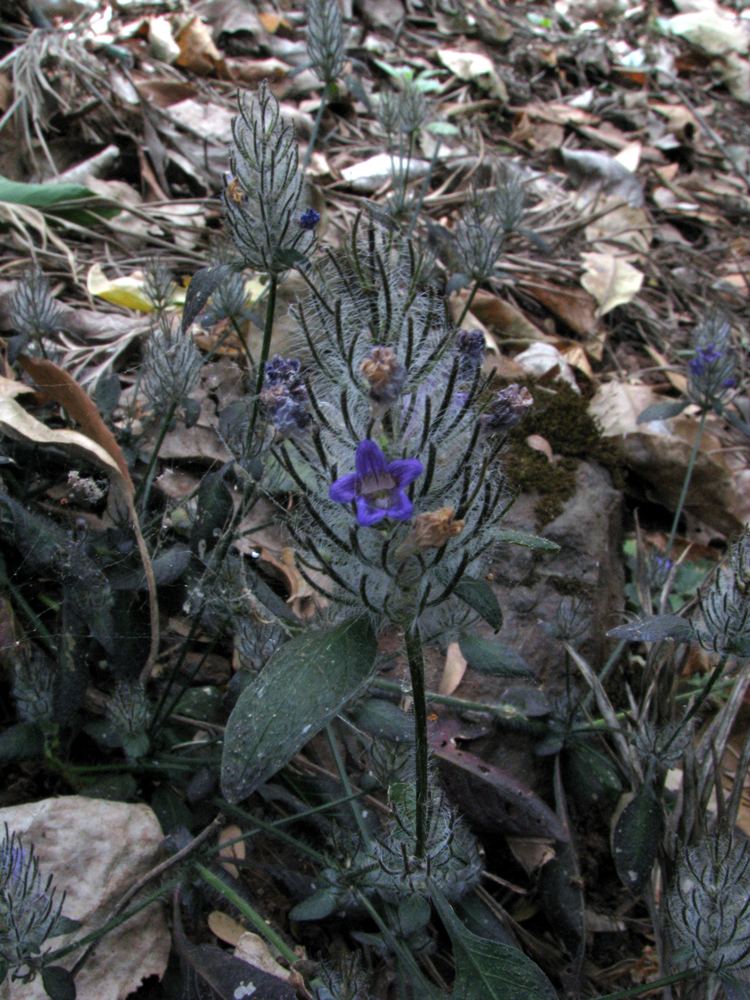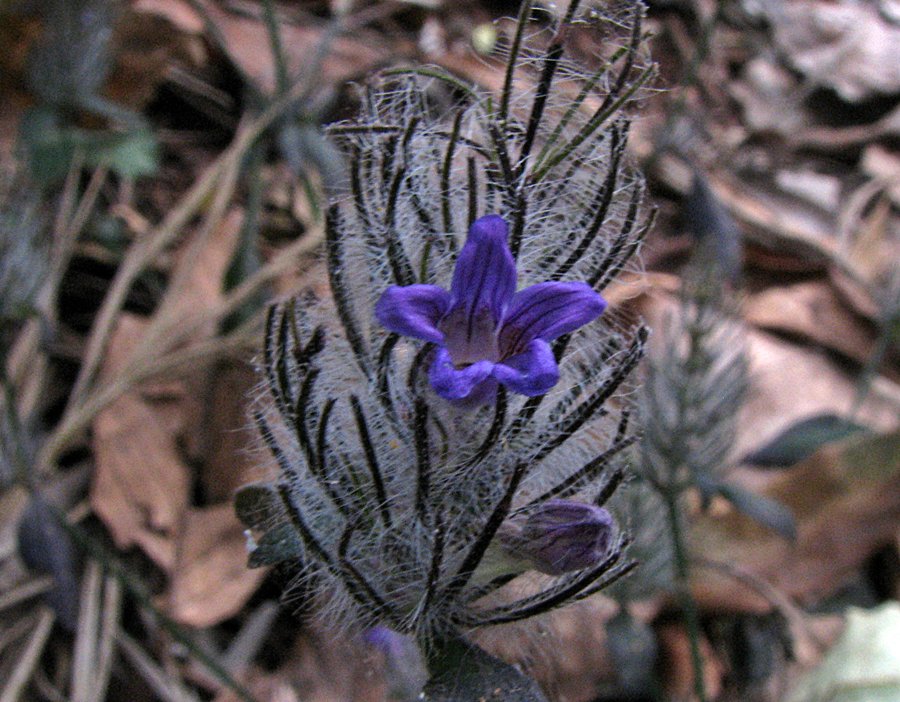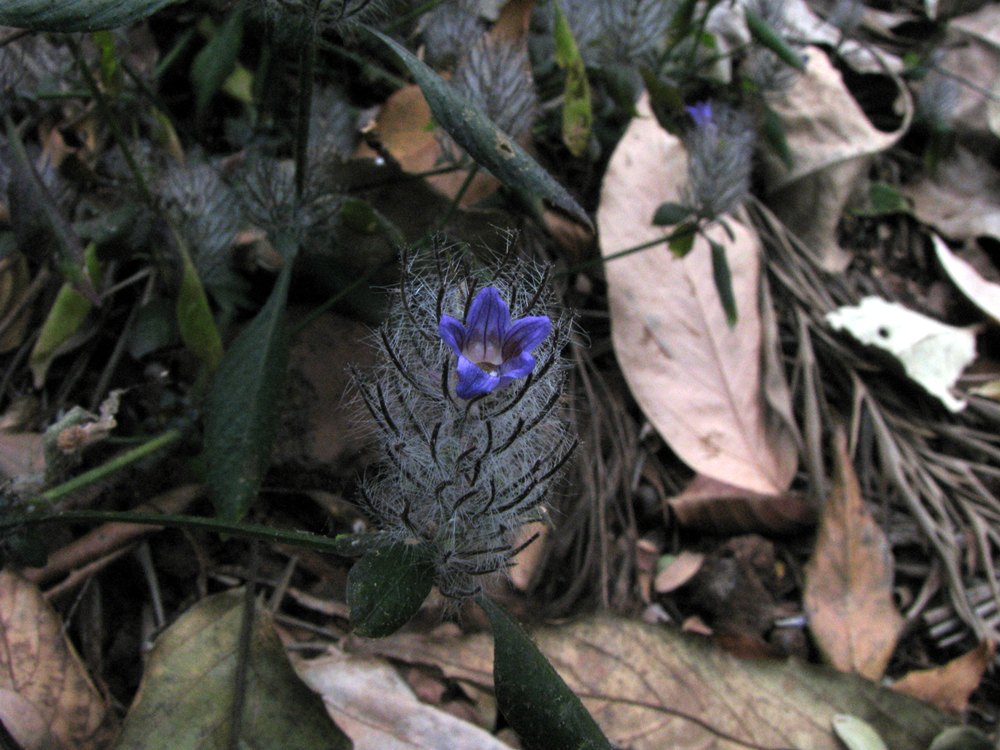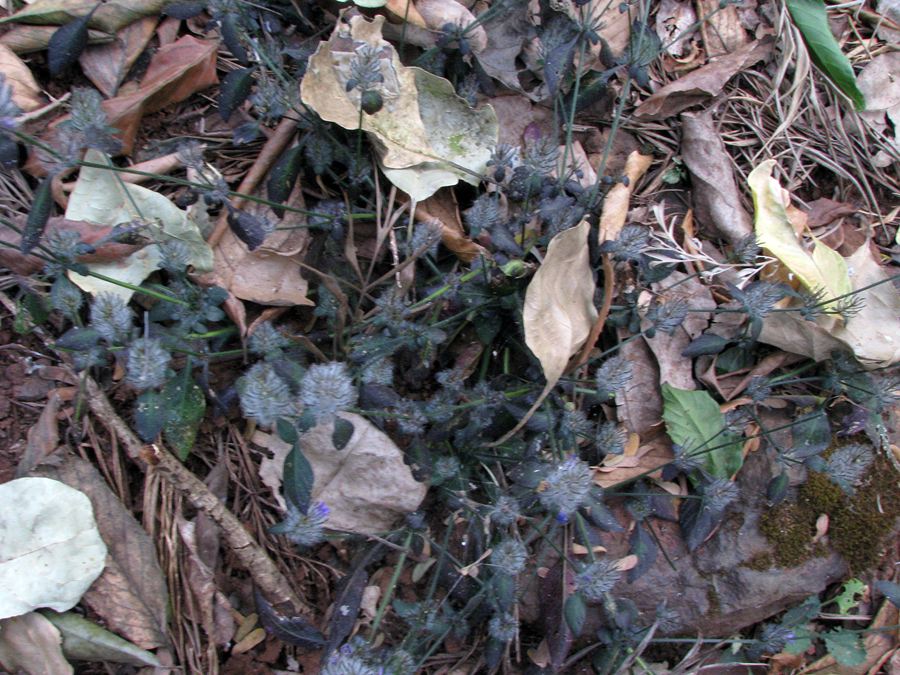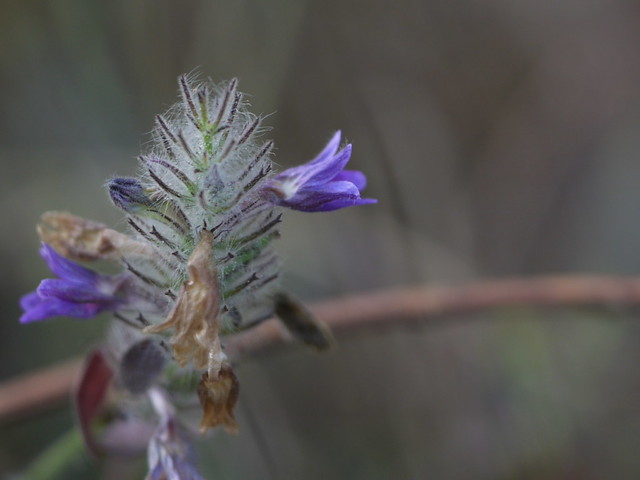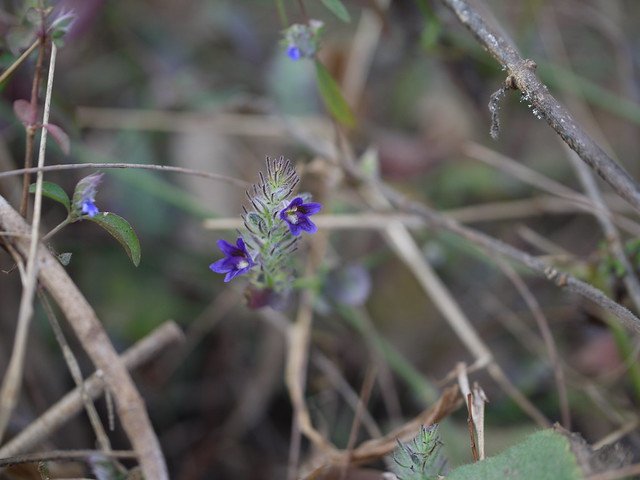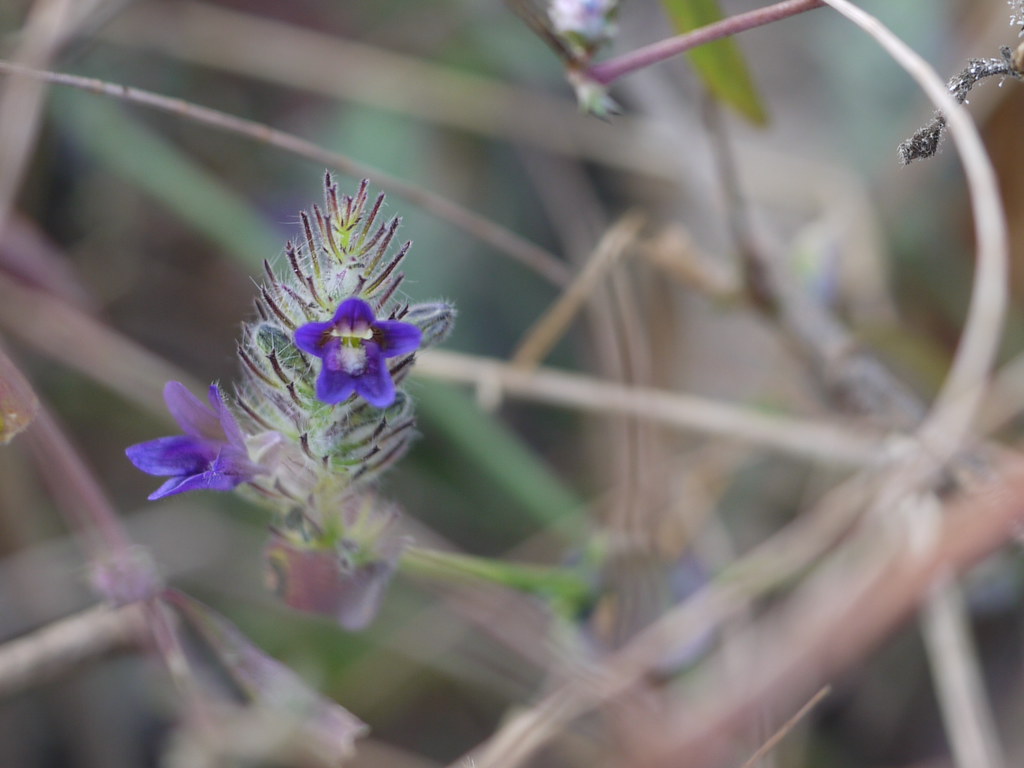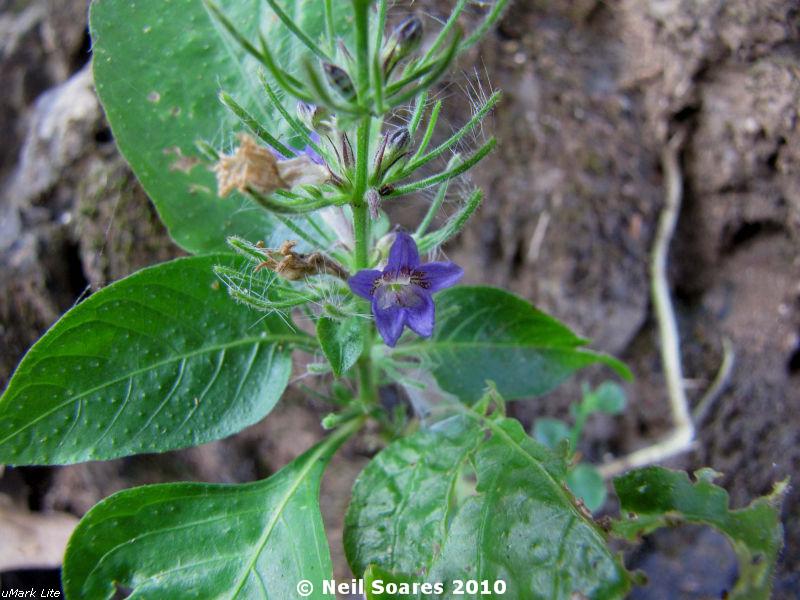|
Haplanthodes tentaculatus (L.) Nees var. neilgherryensis (Wight) J. R. I. Wood, comb. nov. (Basionym: Haplanthus neilgherryensis Wight; Haplanthus tentaculatus (L.) Nees var. neilgherrensis (Wight) C. B. Clarke; Bremekampia neilgherryensis (Wight) Sreem.; Haplanthodes neilgherryensis (Wight) R. B. Majumdar) as per New Names and Combinations in Indian Acanthaceae by John R. I. Wood- Novon: A Journal for Botanical Nomenclature 23(3):385-395. 2014;
. Haplanthodes nilgherrensis (Wight) R.B.Majumdar, Bull. Bot. Soc. Bengal 25: 76 1971. (basionym: Haplanthus neilgherryensis Wight Icon. Pl. Ind. Orient. [Wight] 4: t. 1556. 1850 [May 1850]) as per IPNI;
.
As per efi thread:
H. verticillatus has cladodes 2.5cm or longer, stiff, very sharp pointed bifid or rarely trifid …accidental prick is very painful, stinging. Plant about a meter tall or less, stout. Flowers light to deep shade of violet.
In H. tentaculatus cladodes are up to 1.5cm, soft, hairy, tip inconspicuously bifid, non-prickly. Three varieties can be recognised by cladodes… In var. plumosa cladodes are covered in dense soft white hairs, inflorescence which is actually terminal part of stem and branches, looking like plume. In var. neilgherryensis terminal spike of cladodes and flowers is densely packed, meaning by, internodes are very small. And of course cladodes not plumose. Var. tentaculatus seen in suitable habitat in Surat, is having cladodes sparsely hairy, nodes widely spaced. Cladodes are pointed upwards in Haplanthodes tentaculatus (Nees) Majumdar or its two other varieties, while these are pointed either straight or downwards in Haplanthodes verticillatus (Roxb.) R.B.Majumdar
. Acanthaceae Fortnight :: Haplanthodes neilgherryensis – White :: Chikmagalur :: PKA-MAR59/59: : 1 post by 1 author. Attachments (6)
Profusely branched herb seen in Chikmagalur Region, Karnataka.
I had seen flowers in White as well as Blue colours.. Bot. name: Haplanthodes neilgherryensis Family: Acanthaceae Date/Time: 27-01-2014 / 02:00PM Habitat: Wild Plant Habit: Herb Acanthaceae Fortnight :: Haplanthodes neilgherryensis – Blue :: Chikmagalur :: PKA-MAR60/60: : 1 post by 1 author. Attachments (4) Haplanthodes neilgherryensis (Blue flowers) . Haplanthodes neilgherryensis – White- 01032014-PKA-March-05 : 5 posts by 4 authors. Attachments (6).
Profusely branched herb seen in Chikmagalur Region, karnataka. Very beautiful … your tour has been very very fruitful..thanks for sharing your recent collection.. Thanks, …,
In view of the taxonomic confusion, we have to see whether it’s Haplanthodes nilgherrensis (Wight) R.B.Majumdar or Haplanthodes tentaculatus (L.) R.B.Majumdar as pointed out in another thread.
Haplanthodes nilgherrensis (Wight) R.B.Majumdar & Haplanthodes tentaculatus (L.) R.B.Majumdar are accepted names of the species & both are different. This genera is endemic to India. Thus we have to sort out our plants at Haplanthodes tentaculatus into these two species.
. Haplanthodes neilgherryensis – Blue- 01032014-PKA-March-06 : Attachments (4). 5 posts by 3 authors.
Haplanthodes neilgherryensis (Blue flowers) Thanks, …,
Haplanthodes tentaculatus (Nees) Majumdar, Bull. Bot. Soc. Bengal 25:76. 1971(Syn: (≡) Haplanthus tentaculatus Nees (basionym); Synonyms: Bremkempia tentaculatus (L.) Sreemadhavan in Almeida, Fl. Mah. 4: 22, 2001. Ruellia tentaculata L. Cent. Pl. 2: 22, 1756. Haplanthus tentaculatus (L.) Nees in DC., Prodr. 1: 513, 1847 (p.p.); Cooke, Fl. Pres. Bombay 2: 453, 1958 (Repr.). H. tentaculatus (L.) var. nessiana Sant. in Bot. Mem. Univ. Bombay 2: 52, 1951.);
Haplanthodes tentaculatus (Nees) Majumdar, Bull. Bot. Soc. Bengal 25:76. 1971(Syn: (≡) Haplanthus tentaculatus Nees (basionym)) as per GRIN.
The Plant List Ver.1.1 (Haplanthodes nilgherrensis (Wight) R.B.Majumdar is an unresolved name. This name is unresolved, but some data suggest that it is synonymous with Haplanthus nilgherrensis Wight )
Hope somebody is able to resolve it.
I am considering it as a syn. of Haplanthodes tentaculatus based on discussions so far in efi. More details in Indian litrature are at Haplanthodes As per these, Haplanthodes nilgherrensis (Wight) R.B.Majumdar & Haplanthodes tentaculatus (L.) R.B.Majumdar accepted names of the species & both are different. This genera is endemic to India.
Thus we have to sort out our plants at Haplanthodes tentaculatus into these two species.
Acanthaceae fortnight ANMAR23/58 Hemigraphis(?) sp. for identification : 8 posts by 4 authors. Attachments (13) Family: Acanthaceae Haplanthus nilgherrensis Wight? Probably Justicia sp Doesn’t Justicia have strongly two lipped corolla, …? Haplanthus nilgherrensis fits perfectly sir. Maybe the accepted name is in doubt. But the illustration attached to the name Haplanthus nilgherrensis Wight is a match for me. Thank you very much. Thank you …, please read, in my earlier reply, Ruellia tentaculata L., in place of R. tentaculata Nees, synonymous with Haplanthus tentaculatus Nees as per FBI. Acanthaceae Fortnight :: Haplanthodes verticillatus :: Devgad :: ARKMAR-05/17 : 1 post by 1 author. Attachments (4) I feel it should be Haplanthodes tentaculatus (Nees) Majumdar as per images herein. I think more closer to Haplanthodes tentaculatus (L.) Nees var. neilgherryensis (Wight) J. R. I. Wood rather than Haplanthodes tentaculatus (Nees) Majumdar (Type variety) Acanthaceae Fortnight :: Haplanthodes verticillatus :: Bondla WLS :: DVMAR49/60 : 1 post by 1 author. 3 images. I think it should be Haplanthodes tentaculatus (L.) Nees var. neilgherryensis (Wight) J. R. I. Wood as per images herein. Sorry, it should be Haplanthodes tentaculatus (Nees) Majumdar as per images herein. I think more closer to Haplanthodes tentaculatus (L.) Nees var. neilgherryensis (Wight) J. R. I. Wood rather than Haplanthodes tentaculatus (Nees) Majumdar (Type variety) Wild Plant For ID : Nasik : 070514 : AK-15 : 4 posts by 3 authors. Attachments (2). May be Acanthaceae. Haplanthodes tentaculatus [Acanthaceae].
Re: [efloraofindia:31341] Haplanthodes sp? 020410-PKA1 – Part 1 : Attachments (3) Before … provided us KEY to Haplanthodes in the other thtread I referred this post in the same thread, comparing it with … post in another thread. At that time I agreed with … Presently I have slight hesitations. not much to reject the probability. … uploads clearly shows sepal character, to me it was/is H. plumosa. In this thread the 2nd pic shows sepals, but it is not clear if those are plumose or not.
Now, … has identified and uploaded all three, H. verticillatus, H. neilgherryensis and H. plumosa, in different threads.
In the pictures in this thread I see some similarity to another thread where … himself identified the species as H. neilgherryensis – https://groups.google.com/d/msg/indiantreepix/, specially in calyx in rk_for-id_060_3.jpg.
Finally, I think we can reject verticillatus and tentaculatus undoubtedly.
Since cladodes in this set of pics are not glandular hairy we have no other option (as per latest KEY by …). Neil Sir is always correct. To me it appears like Haplanthodes tentaculatus (Nees) Majumdar as per images herein. I think more closer to Haplanthodes tentaculatus (L.) Nees var. neilgherryensis (Wight) J. R. I. Wood rather than Haplanthodes tentaculatus (Nees) Majumdar (Type variety).
But I am not too sure.
Pl. confirm.
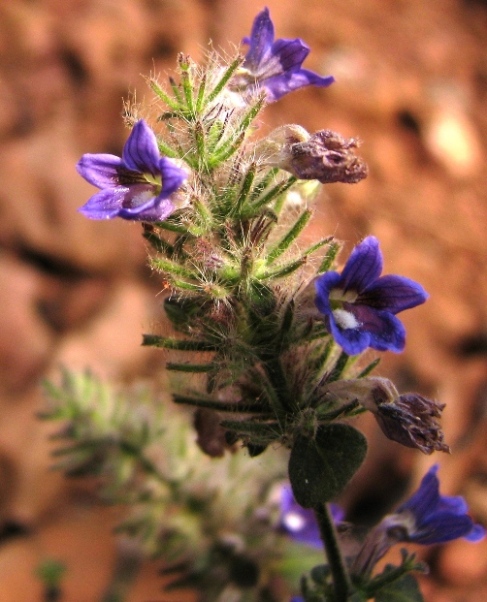 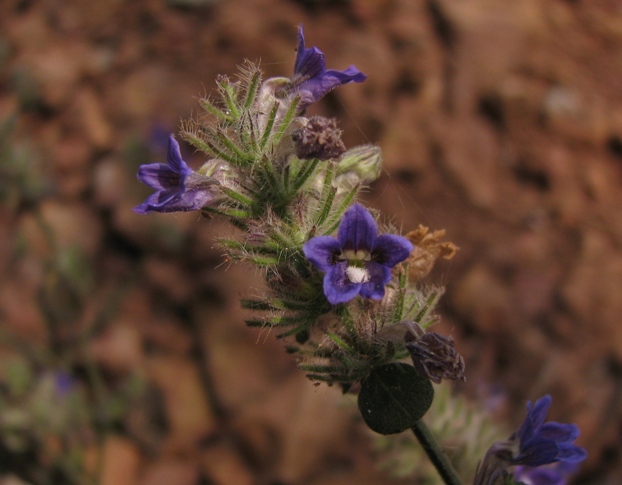 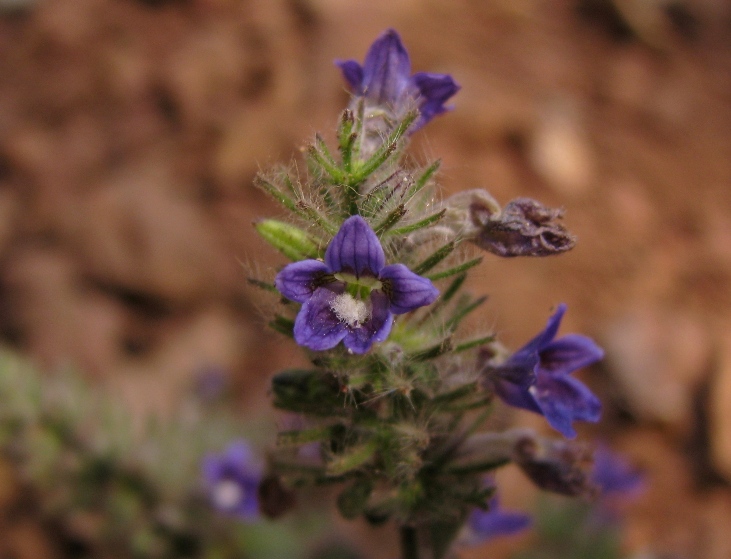 Acanthaceae Fortnight ::Haplanthodes sp? :: Ganapatipule:: PKA-MAR29/29: : : 23 posts by 4 authors. Attachments (3) Came across this Haplanthodes sp. at Jaigad fort near Ganapatipule. Could this be Haplanthodes plumosa?. Kindly validate the ID.
efi page on Haplanthodes plumosa
Haplanthodes species in eFIoraofindia (with details/ keys from published papers/ regional floras/ FRLHT/ FOI/ efloras/ books etc., where ever available) Does anybody have access to http://www.bioone.org/doi/abs/10.3417/2013046? I asked if any member can access the paper http://www.bioone.org/doi/abs/10.3417/2013046. What I come to know is that Haplanthodes tentaculatus (L.) Nees is further divided in to var. nilgherryensis and var. plumosa, besides type species.First, I do not have literature, be it century old, on South Indian flora. I have never seen one physical species, never before even in images. The first time I saw/noticed it in Anurag Ji’s thread. Second, it appears to me that various uploads of Haplanthodes, in eFI, are very confusing.
Third, internet doesn’t feature any photograph of related species other than those of …, … and one or two of others.
Fourth, I do not even know how to differentiate H. verticillatus from H. tentaculatus.
… threw some light –
FBI recorded, corolla in H. verticillatus (verticillaris) is pale lilac; against dark lilac in http://florakarnataka.ces.iisc.ernet.in/herbsheet.php?id=151&cat=1 and “brilliant blue” in Dinesh Ji’s KEY in link1 above.
… has both white & blue colour H. nilgherryensis.
So, it is quite impossible for me to decipher the id of this species. More so, because except the flowering spikes no detail on sepals, sizes of corolla and calyx etc are available.
If this belongs to H. tantaculatus group it is unlikely to be var. plumosa, because of the following herbarium –
Herb. of Ruellia tentaculata – http://linnean-online.org/6882/
possibly type species – http://apps.kew.org/herbcat/getImage.do?imageBarcode=K000885683
var. nilgherrensis –
var. plumosa –
I think var. plumosa doesn’t have dense spike. I believe I may have a resolving idea to put forth but first I would like to know if: and also, as a continuation of 2) =Haplanthus tentaculatus group? Yes for both of your questions, I think …
q2 = I used the term “H. tentaculatus group”, for the type species as well as var. nilgherrensis and var. plumosa.
Haplanthodes is synonymous with Haplanthus and also with Berekampia in our cases. Based on Gamble and Flora of Hassan District (attached), Biodiversity in India and JCB:
In the above cases, whether we: Well, …, I missed the glandular cladode of H. verticillaris. And also fruit size was unknown to me. Attached here the FBI entries. I stressed on calyx character which was not visible in attached pictures, couldn’t make out length of cladode in various threads.
Thank you very much for those differentiating characters.
Sorry, here is the FBI. Thank you sir. I still do not know what to make of the difference between the var. under Haplanthodes tentaculata. I do not know. Since we do not have other source we will have to depend on FBI. I copy a few words –
Type species : cladodes in fruits glabrous or pubescent, not ciliate; calyx pubescent, scarcely ciliate; corolla less than 1/2 inch, white (blue, lilac – Pullaiah)
var. Plumosa : calyx densely hispid-hairy subplumose
var. nilgherrensis (neolgherryensis) : you have lit.
Your species had capsule slightly curved (check KEW herb K000885689), while after checking plumosa herb. at KEW site it appears to me plumosa capsules are a bit shorter and straight.
I think if these details can not be ascertain we need to go to var. plumosa, but leave it at H. tentaculatus only. This does not apply to neilgherryensis I copy here the KEY, based on various lit, you have provided –
Please check the thread. To me cladodes seem to be gladular, yet number of teeth is two in some & three in others. What do you think? Well sir, in one Flora that I saw, it said cladodes in H. verticillatus generally 2 toothed, rarely 3. I cannot find it right now. Will attach when I do. If Haplanthus verticillaris Nees can have 3 teeth sometimes then number of teeth won’t be a KEY to id species. Attached here what Wight recorded about cladode teeth in H. nilgherrensis. Please note what Wight referred to “bract” may be he meant cladode.
After going through all uploads of Haplanthus/Haplanthodes I think –
However, I think I have found H. t. var. plumosa! Here it is – efi thread. Check the two photographs in highest resolution, you will see plumose sepals clearly. Besides, each pseudo-whorl in that plant gives rise to sub-branches which do again form flowering pseudowhorl of cladodes (… pointed out this character in a thread). Please also compare those two pics with another upload(s) by … – Note the darker pattern in corolla lobes in both the thread
Attachments (1)
Thanks sir. One question- are the pseudowhorls forming further branches not seen ANY of the other threads on the group? Our concern is with only two species of FBI, …, Haplanthus verticillaris and H. tentaculatus. The later includes var. nilgherrensis and var. plumosa. btw, Calyx of H. verticillaris is 1 line (1 line = 2.1 mm). corolla 6 line long (note the calyx to corolla ratio); calyx glabrous or nearly so (ref. http://www.herbier-mpu.org/zoomify/zoomify.php?fichier=MPU018249). I have a request sir.
Could you please summarize our entire discussion so as to be referred to in the future when another post of Haplanthodes sp. comes up? This would be quite helpful for me as well.
following is the synopsis (based on very limited resource we have discussed and pasted links) – verticillaris (verticillatus ) = 19 mm to 30 mm
tentaculatus (incl. var.) = 06 mm to 20 mm
glandular hairs on cladodes :
verticillaris (verticillatus ) = present
tentaculatus (incl. var.) = absent (in all var.?)
calyx :
verticillaris (verticillatus ) = 2 mm long, glabrous or pubescent
tentaculatus =
(please note KEW has herb. featuring intermediate form of var. tentaculatus and var. neilgherryensis
colour of corolla :-
uncertain to me in all species and var.
Capsule size also uncertain (ref. JCB & Pullaiah); number of seeds not known to me; seed of tentaculatus is smaller than verticillaris (ref. FBI) Thank you very much sir- for the discussion and the summary! Good evening sir. While going through the various flora in my college taxonomy lab, I found this in the Flora of Nasik District (P. Lakshminarasimhan and B.D Sharma). All four species have been keyed out Thanks … for the KEY to four species. But, does it help us to identify the species we/I have discussed so far in the following three threads? –
Would you please identify the above threads again? No sir, I am afraid without a clear view of the capsules, I wouldn’t know where to start.
But in this thread, would you say that the capsule is pubescent or glabrous? No Sir …, I am unable to tell you if the capsules in your thread are pubescent or not! That is why I think the KEY from your college taxonomy club doesn’t help me much in these cases!
Not only that, according to the KEY of that book H. neilgherryensis should have glandular hairy cladodes. I am not sure if those cladodes in your plant were glandular or not. Perhaps a few glandular hairs are there in DSC_0739.jpg (below the flower) and in DSC_0743.jpg (bottom of the pic).
In fact, this prolonged and intermittent discussion along with so many KEY in various sources makes it more and more complicated.
Yet, based on distribution,your species is not plumosa; based on hair on cladodes your species is not tentaculatus; based on this thread your species is not verticillatus. Thank you sir. As a final note, I would make sure to shoot with a scale next time so that atleast a few doubts arising as a result of no scale measurements can be avoided! I feel it should be Haplanthodes tentaculatus (Nees) Majumdar as per images herein. I think more closer to Haplanthodes tentaculatus (L.) Nees var. neilgherryensis (Wight) J. R. I. Wood rather than Haplanthodes tentaculatus (Nees) Majumdar (Type variety).
But I am not too sure.
Pl. confirm.
. Tamil name of Haplanthodes neilgherryensis (Wight) R.B.Majumdar: Please help with the Tamil name kambalipoo kurinji of Haplanthodes neilgherryensis (Wight) R.B.Majumdar
The transliteration is okay, but the actual pronunciation of this name would include the consonant ப் to read கம்பளிப்பூ குறிஞ்சி. So I suggest using this format. Thank you very very much, …, for helping with the proper spelling of the name !!! . Names of Plants in India :: Haplanthodes neilgherryensis (Wight) R.B.Majumdar: 1 image. ¿ hap-LANTH-oh-deez ? — Greek: haplos (single); anthos (flower)
¿ kneel-ghey-ree-YEN-sis ? — of or from Nilgiri Hills; Neilgherry is the Anglicised name of Nilgiricommonly known as: Nilgiri haplanthodes • Gujarati: નીલ જકારા nil jakara • Konkani: व्हडलें काळें किरायतें vhadlem kalem kiraytem • Marathi: निळा जकारा nila jakara • Tamil: கம்பளிப்பூ குறிஞ்சி kambalipoo kurinji botanical names: Haplanthodes neilgherryensis (Wight) R.B.Majumdar … homotypic synonyms: Bremekampia neilgherryensis (Wight) Sreem. • Haplanthodes tentaculata var. neilgherryensis (Wight) J.R.I.Wood • Haplanthus neilgherryensis Wight • Haplanthus tentaculatus var. neilgherryensis (Wight) C.B.Clarke … accepted infraspecifics: Haplanthodes neilgherryensis var. neilgherryensis … POWO … same as Haplanthodes tentaculatus (L.) R.B. Majumdar var. neilgherryensis (Wight) J.R.I. Wood … Botanical Survey of India distribution in India: Rajasthan, Daman and Diu, Maharashtra, Goa, Karnataka, Kerala, Tamil Nadu, endemic to India … Botanical Survey of India Bibliography / etymology ~~~~~ ENGLISH ~~~~~
Nilgiri haplanthodes
~~~~~ GUJARATI ~~~~~
નીલ જકારા nil jakara
~~~~~ KANNADA ~~~~~
no given name / no name found
~~~~~ KONKANI ~~~~~
व्हडलें काळें किरायतें vhadlem kalem kiraytem
~~~~~ MALAYALAM ~~~~~
no given name / no name found
~~~~~ MARATHI ~~~~~
निळा जकारा nila jakara
~~~~~ RAJASTHANI ~~~~~
no given name / no name found
~~~~~ TAMIL ~~~~~
கம்பளிப்பூ குறிஞ்சி kambalipoo kurinji
~~~~~ x ~~~~~
Names compiled / updated at
https://dineshvalke.blogspot.com/2023/01/haplanthodes-neilgherryensis-wight.html . Gujarati name of Haplanthodes neilgherryensis (Wight) R.B.Majumdar: Many thanks … for following up with this query.
I have used the name nil jakara નીલ જકારા for Haplanthodes neilgherryensis (Wight) R.B.Majumdar
Please consider this query as resolved.
In earlier times, Haplanthodes neilgherryensis (Wight) R.B.Majumdar was considered as synonym / variety of Haplanthodes tentaculata (L.) R.B.Majumdar, and the name nil jakara નીલ જકારા was given to the plant during those times. Now H. neilgherryensis is considered as a separate species. Actually nil jakara નીલ જકારા is more apt for H. neilgherryensis because it bears blue-coloured flowers, while H. tentaculata is off-white, brownish in the throat.
. References: New Names and Combinations in Indian Acanthaceae by John R. I. Wood- Novon: A Journal for Botanical Nomenclature 23(3):385-395. 2014; |
Haplanthodes tentaculatus var. neilgherryensis
Updated on December 23, 2024

